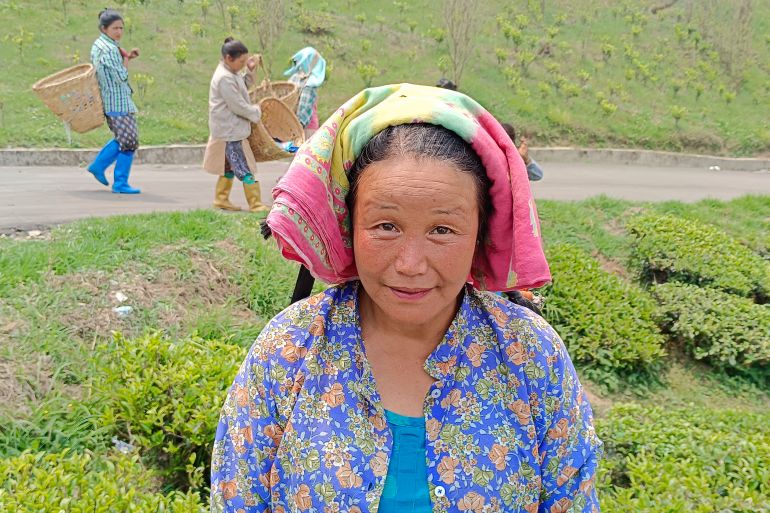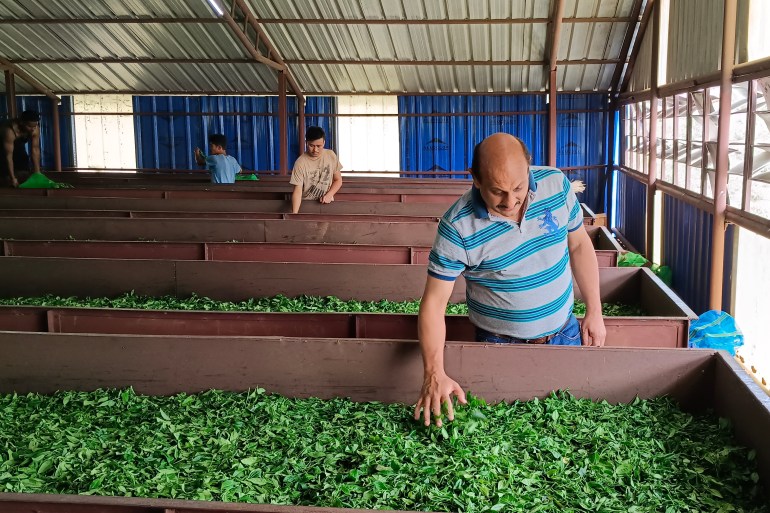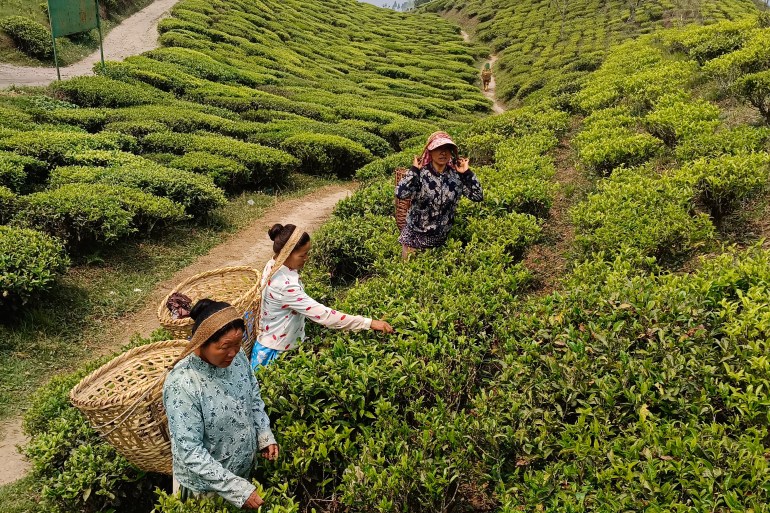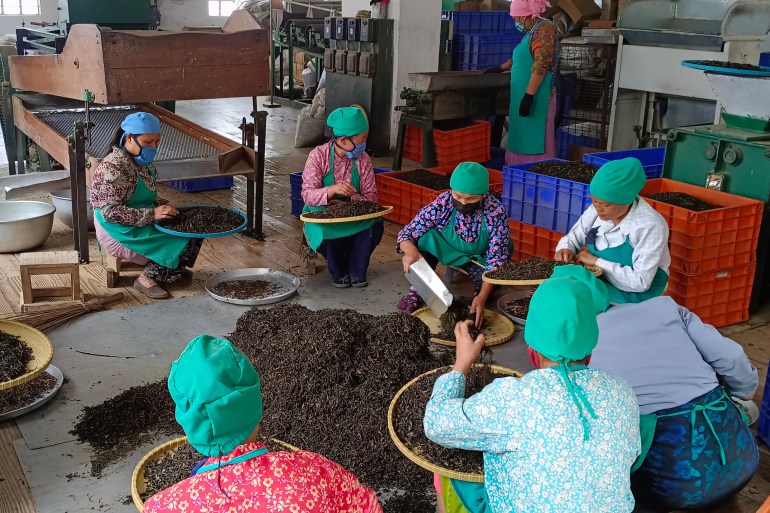Cheap Nepal tea hits India’s Darjeeling tea sales
Cheaper alternatives from Nepal, as well as rising costs of domestic production, have slashed demand for the ‘champagne of teas’.

Kolkata, India – World-famous Darjeeling tea gardens in India’s West Bengal state immediately whip up picturesque visuals of clouds floating over rolling hills covered in tea bushes where women, draped in colourful sarongs, pick tea leaves that they collect in woven baskets tied to their backs.
But there is another reality behind those postcard visuals: a drop in production and demand as buyers turn to cheaper alternatives from neighbouring Nepal, endangering the future of an area, and its workers, once known for producing the “champagne of teas”.
Keep reading
list of 4 itemsWhy is China banning officials and state employees from using iPhones?
China’s Alibaba sees shares tumble as outgoing CEO quits cloud business
China says reports it had spy in UK parliament ‘malicious slander’
“The future of Darjeeling tea is bleak and the end seems near if the situation remains the same,” warned Subhasish Roy, the manager of Arya Tea Estate in Darjeeling. “Several thousands of people will lose their livelihood and this heritage will be lost forever.”
The iconic Darjeeling tea industry was started by the erstwhile British rulers who replanted bushes on the Indian hills from China in the mid-19th century.
Today, the hills have 87 tea gardens spread across 17,800 hectares (44,000 acres) with a total production of about 6,640 tonnes (6.64 million kg or mkg) of organic tea in 2022, lower than the 7.69mkg produced in 2019, according to the Tea Board of India, the apex body of the tea industry.
Tea experts attribute several reasons for the falling production, including a nearly 40 percent decline since the gardens were converted to fully organic to meet buyer demand, said Sanjay Choudhry, the owner of Ringtong tea estate.
“We are also facing a severe labour shortage as the young generation is not ready to enter the industry and migration is rampant. Climate change is another reason for the decline in production,” he added.
Dip in exports
The premium quality tea caters mostly to the international markets of Russia, Japan, Iran, the United States and European countries. But there has been a decline in exports to these nations in the past five years.

In 2022, Darjeeling exported 3.02mkg of tea or 45.48 percent of all production, down from 3.71mkg or 48.24 percent of the production in 2018, as per the Tea Board.
Even the overall export of Indian tea was down to 226.98mkg in 2022 from 251.91mkg in 2017, it said.
Darjeeling tea producers blame the neighbouring country of Nepal and its free trade agreement with India as one of the key reasons for squeezing their market share.
In 2022, Nepal exported about 15mkg of orthodox tea to India, up from 10mkg the previous year, according to the Tea Board. Orthodox tea refers to loose tea leaf which is produced using traditional or orthodox methods, including plucking, rolling, and drying. In Darjeeling, the tea gardens have factories to process tea leaves. In Nepal, they tend to sell tea leaves to factories.
Indian tea estates, unlike those in Nepal, are also required to provide benefits like provident fund, gratuity, and medical facilities, among others, pushing up costs.
Ashok Lohia, chairman of Chamong tea estates which has 14 tea gardens in the hills and is one of the largest exporters of Darjeeling tea, says that Nepal has many advantages over India.
“Their orthodox production mainly comes from small growers who do not have processing factories and thereby their costs are much lower compared to us. Nepal tea also enjoys free trade with India but other neighbouring countries such as Bangladesh and Sri Lanka [are charged] 100 percent import duty” on their sales to India, Lohia said.
Poor prices
High wages in the hills and low export price has also taken a toll on the industry, he said.
“About 70 percent of the cost of production comprises manpower and wages,” Lohia said. For instance, he said, around the year 2000, tea pluckers earned about 35 rupees per day ($0.42) while the export price of tea was approximately 10 euros ($11). Today, the wages are 250 rupees per day ($3) while the export price is $19-$20 per kg.

Berlin-based Gunter Faltin is one of the largest importers of Darjeeling tea to European countries. European demand, he said, is suffering because of “a double whammy of recession and pandemic that has reduced the buying capacity of our customers”.
On a recent visit to Darjeeling, he told Al Jazeera he was worried that the rising imports of cheap Nepal tea would “destroy” the livelihoods of thousands of tea pluckers in Darjeeling. It is hurting his business as well, he admitted.
The Darjeeling tea industry directly and indirectly employs about 300,000 people, which also includes 55,000 female tea pluckers.
Even the pluckers are apprehensive about their future pointing to their colleagues who were laid off or have not received their benefits at the 20 plantations that are running in losses.
“We are still getting our wages and other payments on time but don’t know how long it would continue as the overall condition is not good … I am apprehensive about my future,” Sarla Thapar, 45, a tea plucker at Arya Tea Estate, told Al Jazeera.
According to Jeetendra Malu, the president of the Darjeeling Tea Association, nearly 30 percent of the gardens are defaulters and have not cleared the statutory benefits of their staff, like provident funds and gratuities. Problems started in 2017 and have worsened since, he added.
Downfall began in 2017
Tea growers in the hills say the nearly five-month shutdown in the hills by a political outfit over its demand for a separate state in 2017 proved disastrous for the tea industry, and it could never fully recover from it.
“The strike couldn’t have come at a worse time as it was a peak season for the first and second flush of tea that is our premium product,” said Sumon Majumder, general manager of Hmp Group Kolkata and exporters of Darjeeling tea. “The International buyers who had already made the orders were waiting for the supply but the shutdown stopped everything.”
“The global importers began to look for an alternative to buy tea similar to Darjeeling and stumbled upon Nepal that produced almost similar in looks but different in flavour and which was incidentally grown in the same altitude and climatic conditions with less cost of production. They cannot match our quality but exporters branded it as Himalayan tea in the international market and sold at a better price,” he said.

Even domestic buyers began to blend Darjeeling tea with cheap quality Nepal tea to mint money as customers could hardly spot any difference between the two teas.
Ringtong tea estate’s Choudhry has also raised serious questions with the Tea Board on the health hazards caused by Nepal tea and said Monocrotophos, a banned insecticide, is rampantly used in Nepal.
“The Food Safety and Standards Act mandates the check of 34 health parameters at National Accreditation Board for Testing and Calibration Laboratories [NABL]-accredited government lab before being deemed fit to supply in India. But the proper lab tests [on imports from Nepal] are hardly done, putting the lives of people in danger.”
What’s the way out?
The Darjeeling tea industry has been unanimously demanding a revision in India’s Free Trade Agreement with Nepal and strict implementation of a geographical indication (GI) tag that prohibits blending of Darjeeling with other teas.
In 2004, Darjeeling tea became the first Indian product to receive a GI tag due to its distinctive flavour and aroma.
“Undoubtedly, Darjeeling tea industry is on a ventilator and the situation is too bad. But we have to look for new International markets to survive. We cannot always blame the [foreign buyers] … We have to also explore the domestic market to expand our reach and find new buyers,” said Anshuman Kanoria, chairman of the Indian Tea Exporters Association.
“We have to also strictly enforce GI tag and enforce an import duty to save our industry otherwise the end is not far,” he added, especially since some international buyers have stopped all purchases of Darjeeling tea after the 2017 agitation.
Senior officials of the Tea Board said they were looking into the matter. “The board has already submitted a proposal [for a financial rescue package] to the Union Commerce Ministry for the tea industry that also includes Darjeeling tea,” said Saurav Pahari, deputy chairman of the Tea Board of India.
The board, he added, has been issuing periodic notifications and circulars to prevent the passing of Nepal tea as Darjeeling tea.
But it has hardly managed to provide any solace to the industry situated in scenic hills. “If given a chance, most of the garden owners would love to exit from picturesque Darjeeling,” Kanoria conceded candidly.